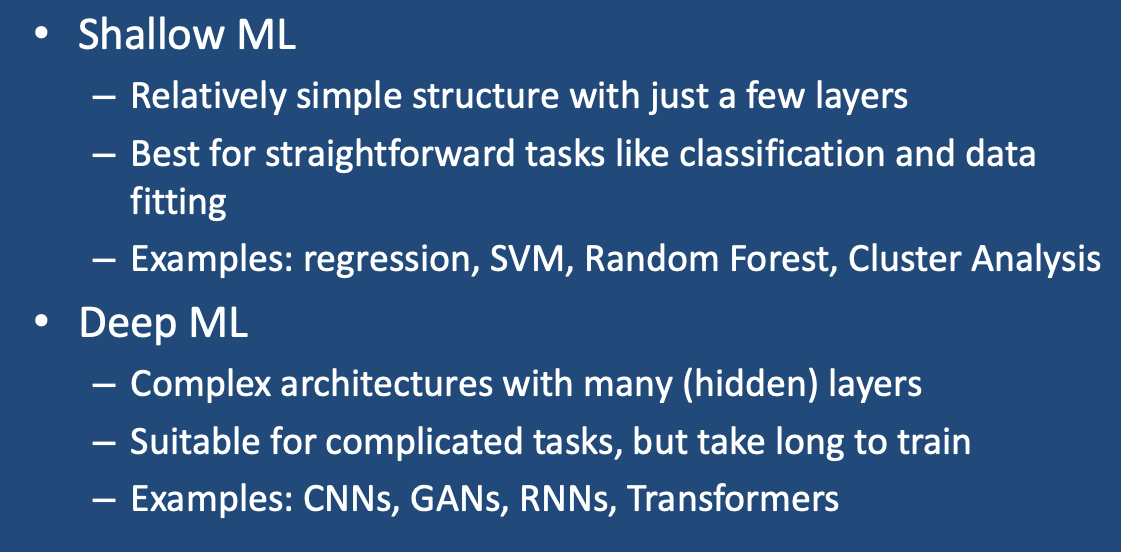Machine Learning (ML) techniques are commonly divided into two classes: shallow and deep. A shallow neural network has only one or a few layers of neurons, while a deep neural network has many. The choice of shallow or deep architecture depends on the complexity of the task, amount of accessible data, and the computational resources available.
 Shallow Neural Network
Shallow Neural Network
Shallow neural networks are comparatively simpler and easier to train. They are suitable for straightforward tasks such as data fitting, classification, and pattern recognition. Examples include logistic regression, support vector machine, random forest, and cluster analysis as pictured below. Shallow networks can be trained quickly with fewer parameters, making them faster to train and requiring less computational resources.
 Deep Neural Network
Deep Neural Network
Deep neural networks, by comparison, have complex architectures containing multiple intervening layers, allowing them to learn more elaborate relationships between inputs and outputs. Deep learning (DL) methods are suitable for tasks such as image and speech recognition, natural language processing, and computer vision. Deep networks require a large amount of data to train and are computationally intensive. However, they can achieve higher accuracy and perform better than shallow networks for complex tasks. Examples of deep networks include convolutional neural networks (CNNs), generative adversarial networks (GANs), transformer networks, and others. These deep learning (DL) methods are so important and complex that they will be discussed later in their own more detailed Q&As.
Advanced Discussion (show/hide)»
No supplementary material yet. Check back soon!
References
Argentiero A, Muscogiuri G, Rabbat MG, et al. The applications of artificial intelligence in cardiovascular magnetic resonance — a comprehensive review. J Clin Med 2022; 111:2866. [DOI LINK]
Breiman L. Random forests. Machine Learning 2001; 45:5-32. (original description of the technique).
Cluster Analysis. Wikipedia, The Free Encyclopedia. (accessed 7-16-22)
Levy JJ, O’Malley AJ. Don’t dismiss logistic regression: the case for sensible extraction of interactions in the era of machine learning. BMC Medical Research Methodology (2020) 20:171. [DOI LINK]
Noble WS. What is a support vector machine? Nature Biotechnology 2006; 24:1565-7. [DOI LINK]
Seif G. The 5 clustering algorithms data scientists need to know. Toward Data Science, 2018;1-10.
Downloaded 7-16-22 from this link. (Recommend viewing online as it contains multiple animated gifs).
Argentiero A, Muscogiuri G, Rabbat MG, et al. The applications of artificial intelligence in cardiovascular magnetic resonance — a comprehensive review. J Clin Med 2022; 111:2866. [DOI LINK]
Breiman L. Random forests. Machine Learning 2001; 45:5-32. (original description of the technique).
Cluster Analysis. Wikipedia, The Free Encyclopedia. (accessed 7-16-22)
Levy JJ, O’Malley AJ. Don’t dismiss logistic regression: the case for sensible extraction of interactions in the era of machine learning. BMC Medical Research Methodology (2020) 20:171. [DOI LINK]
Noble WS. What is a support vector machine? Nature Biotechnology 2006; 24:1565-7. [DOI LINK]
Seif G. The 5 clustering algorithms data scientists need to know. Toward Data Science, 2018;1-10.
Downloaded 7-16-22 from this link. (Recommend viewing online as it contains multiple animated gifs).
Related Questions
Is artificial intelligence the same as machine learning?
Is artificial intelligence the same as machine learning?
